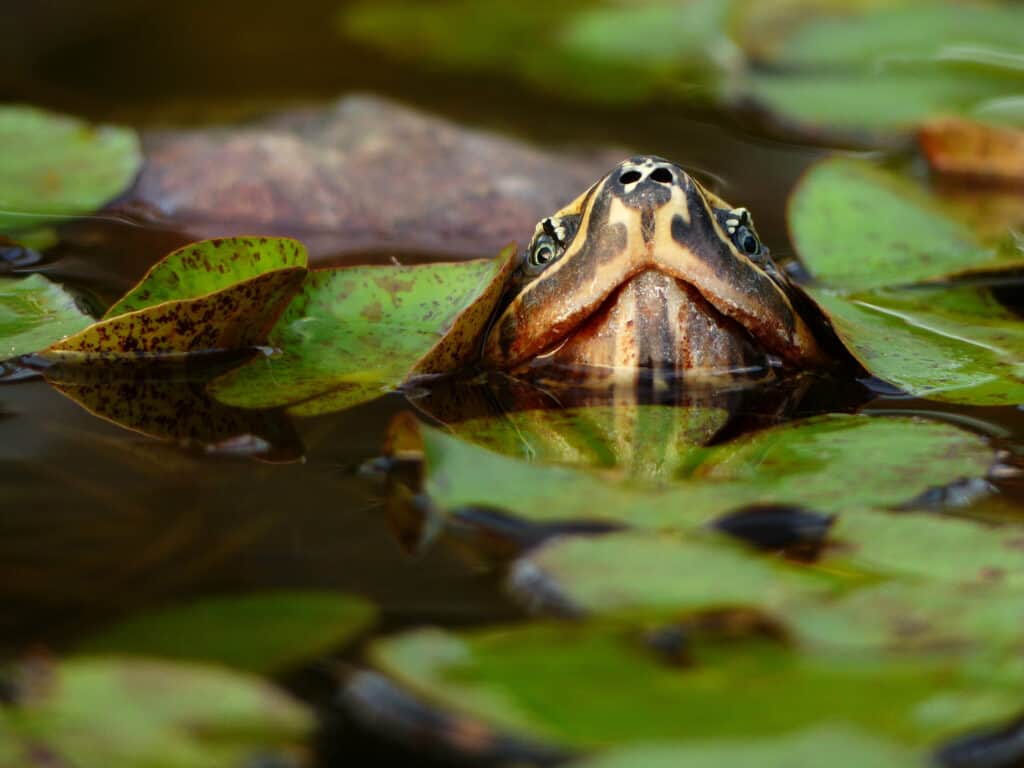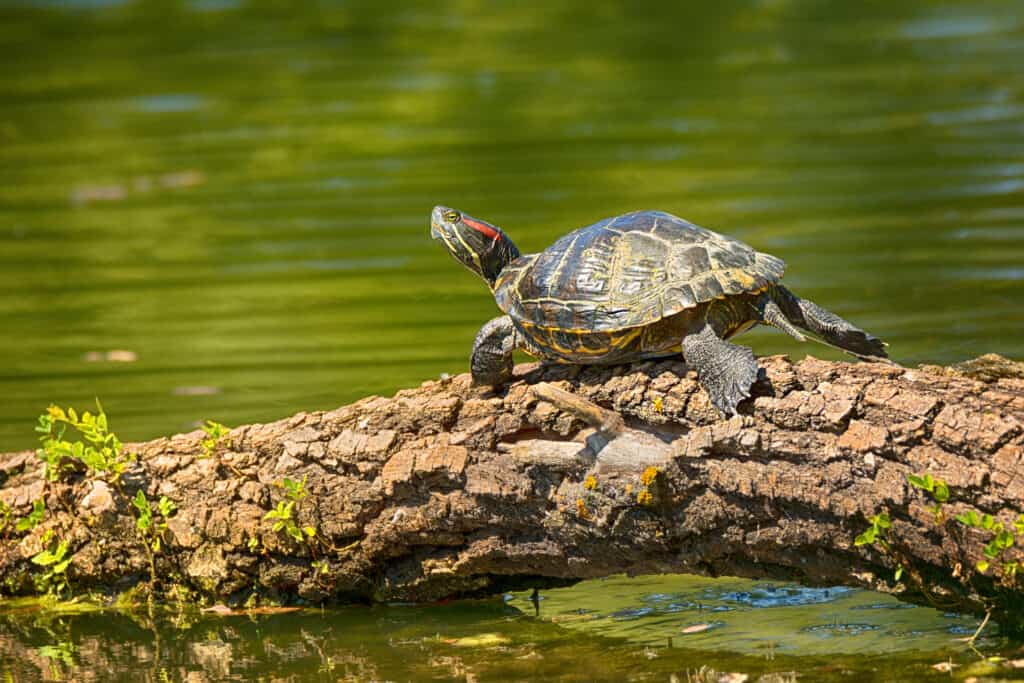
Aquatic turtles are considered exotic and are therefore sought after by some pond owners. In pet shops and zoos, turtles can be seen in ponds from time to time. In garden ponds, they are instead a rarity but in principle, it is possible to keep aquatic turtles in the garden pond. However, it would help if you considered some essential things and carefully considered whether you can offer the turtles what they need. If you are planning a pond first, you can view the turtles’ requirements during the planning stage.
Preliminary Considerations for Keeping Aquatic Turtles
Turtles in a garden pond are exotic and beautiful to look at. Before you buy garden turtles for the pond, you should familiarize yourself with the requirements of these animals. Quickly the animals can take flight and cause significant damage in the wild or be run over by cars. Turtles are natural escape artists. Releasing turtles into the wild is a criminal offense. Turtles can also get up to mischief in your backyard pond, as fish and other animals, as well as aquatic plants, are welcome treats.
Turtles can live to old age, but they are not immune to disease if not kept properly. Since turtles are sun worshippers, it is also crucial to get enough sun. If you want to create a pond and keep turtles first, you should consider this when choosing a location. It would help if you also remembered that the pond in the sun needs proper care. The water can quickly become hot in the summer months and tip over. Algae will form more rapidly in the sun. You will need to remove algae more frequently.
Winterization can also be a problem. Therefore, you should overwinter the turtles indoors and then bring them back outdoors when there are no more night frosts. If you can offer the turtles all these conditions, you should acquire these beautiful, exciting animals. After all, it would not be enjoyable if you had to give the turtles to a sanctuary because the keeping does not work out.
Planning the Garden Pond for Turtles
If you wish to have a garden pond and think about keeping turtles, you should take into account a few things when planning:
- Pond should be large enough and have a water volume of at least 80 gallons (300 liters) per animal.
- A Deepwater zone with a depth of about 3 feet (one meter) must be present and sufficiently large to buffer temperature fluctuations.
- A shallow water zone with a depth of 8 to 16 inches (20 to 40 centimeters) should occupy about two-thirds of the pond area
- No steep transitions between the individual zones
- Sunny location of the pond
- Climbing aids for the turtles
- Escape-proof fencing
If there is a sufficiently sizeable deep water zone, the pond will not cool down so quickly at night and during cool periods in the warmer seasons. If the turtles feel threatened, they can retreat to the deep water zone. In the shallow water zone, the water warms up quickly. The turtles like to stay there when the sun is shining. Therefore, the shallow water zone should be as large as possible. If you already have a garden pond, it is often difficult to convert it to turtles. It would be best if you considered whether this makes sense.
Climbing Aids in the Pond
If you already have a garden pond, you can retrofit climbing aids. The pond liner is too slippery. The turtles keep slipping off it. You can line the pond with coconut fiber mats, which give the little climbers enough grip. However, the coconut fiber mats favor the settlement of algae. It would help if you replaced the coconut fiber mats from time to time. A thin layer of concrete that you place on the pond liner can also provide a climbing aid.
How to Make Your Pond Escape-Proof
A fence is not enough because the turtles use it as a climbing frame. If the fencing does not reach deep enough into the soil, the turtles can burrow through it. If possible, the fencing should be made of glass or Plexiglas and mounted on a foundation that reaches at least 20 inches (50 centimeters) deep into the ground. For height, the rule of thumb is that the fencing should be at least twice the length of the turtle’s shell. If you have several turtles, you should choose the fencing even higher. Turtle carriers like to use their conspecifics as predator ladders. It would be best to increase the fencing by about a third.
You can write your phone number on the turtles’ shells with a non-toxic and waterproof pen for safety. If the animals escape and are found, the finder can notify you. However, you should repeat the procedure from time to time as turtles shed their shells.
A Sunny Place

Turtles are sun-hungry and will take every opportunity to soak up the sun on sunny days. A sunny location is therefore essential for your pond. You should ensure that the shallow water zone is large enough and gets enough sun. In addition, you can place some large rocks or larger areas of pebbles in the shoreline zone for the turtles to bask in.
In the pond, you can create several sun islands. These can be rocks or small logs that stick out of the water a few inches. In case of danger, the turtles can then quickly return to the water from this place.
Tip:
An outdoor halogen lamp provides enough light for turtles during a cloudy summer. It provides additional warmth in cool temperatures.
Hibernate Aquatic Turtles
Aquatic turtles are cold-blooded and go into cold torpor when temperatures are freezing. However, it would help if you did not overwinter your turtles outdoors. If the animals awaken from their hibernation, single night frosts can make life difficult. For example, the turtles may contract pneumonia and die. Laying mortality and shell necrosis can also occur if the turtles are too cold.
An indoor aquarium is ideal for overwintering. It should have a sunny location and provide retreats for the turtles. It is also crucial that it is large enough. No later than the end of October (in Germany), you should bring the turtles indoors and put them in the aquarium. Only then, when there are no more night frosts, can the turtles go back outdoors. The water in the garden pond should be about the same temperature as the water in the aquarium. This will allow the turtles to acclimate more quickly.
Wintering in the garden pond is possible if the pond is large enough and at least one meter deep at the deepest point. This way, it will not freeze completely. In addition, you should always make sure that a spot in the pond remains ice-free. This allows the turtles to reach the water’s surface to breathe quickly. An oxydator provides the necessary aeration of the pond. However, wintering in the pond is not recommended.
Suitable Species of Turtles for the Pond
The turtles should have a length of at least 4 inches (10 centimeters) if they are settled in the garden pond. In addition, you should secure the pond with a net so that the tiny turtles do not make their last journey with herons Air or fall victim to crows, cats, and other hungry animals. You can remove the net only when the turtles have reached a length of about 6 inches (15 centimeters). Suitable species for the garden pond are
- European pond turtle, Emys orbicularis ssp., also ideal for year-round keeping in the garden pond
- Back-striped ornate turtle, Chrysemys picta dorsalis
- Northern red-bellied ornate turtle, Pseudemys rubriventris
Protection Status of Ornamental Turtles
If you buy ornamental turtles, you should pay attention to a certificate of origin. In Europe, ornamental turtles are subject to species protection. With proof of origin, the trade of ornamental turtles is allowed in the EU. Ownership of ornamental turtles is subject to registration. Where you register your turtle depends on the respective federal state. You can find information about the responsible authorities on the internet, for example, the lower nature conservation authority or the state office for environment and nature conservation. If your turtles reproduce, you must also register the offspring.
Food for Aquatic Turtles
There is no single food for aquatic turtles. The turtles feed on water plants and small fish, frogs, newts, and other small animals. If the aquatic plants are to be used as food, you will need to keep replanting. You often have to feed them only when the temperatures are warm. Pet stores often offer food recommended for fish and aquatic turtles. This food is rich in protein. Aquatic turtles require very little protein, and high protein content can even harm their organism.
It would help if you used what the turtles can find in nature as food. Worms, snails, larvae, insects, and small crustaceans are suitable.
Aquatic Plants in the Turtle Pond
Most aquatic turtles love to eat aquatic plants and will not stop at water lilies. It would be best to use non-toxic aquatic plants and then keep replanting. The European pond turtle is less interested in aquatic plants and is also suitable for a pond with lush plants.
It would help to avoid water lilies in the pond when keeping aquatic turtles. Water lilies shade the pond with their large leaves. As a result, the water warms up less.
Fish and Water Turtles
If you keep fish and water turtles in the garden pond, you should choose larger fish such as goldfish or roach. The aquatic turtles readily eat smaller fish. Fish fry and juveniles are also perfect prey for the turtles. It is best to avoid fish when keeping aquatic turtles. Food can also be a problem. The high-protein food you need for the fish is not suitable for aquatic turtles. If the fish do not eat the food or if the turtles eat it, the turtles can get sick in the worst case.
Conclusion
You can keep aquatic turtles in your garden pond, but you should pay attention to their requirements. If you can provide the water turtles with suitable conditions, you should think about keeping them. Aquatic turtles need a sunny place, a sufficiently sizeable deepwater zone, and especially a large shallow water area. They should not spend the winter in the garden pond but an aquarium indoors. Since turtles are true escape artists, you must make the pond escape-proof. If possible, you should not keep fish in the garden pond, as the turtles could eat them. Water plants serve as food for the turtles and should be replanted regularly.